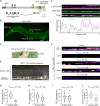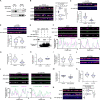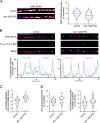The HSPG syndecan is a core organizer of cholinergic synapses
- PMID: 34213535
- PMCID: PMC8258370
- DOI: 10.1083/jcb.202011144
The HSPG syndecan is a core organizer of cholinergic synapses
Abstract
The extracellular matrix has emerged as an active component of chemical synapses regulating synaptic formation, maintenance, and homeostasis. The heparan sulfate proteoglycan (HSPG) syndecans are known to regulate cellular and axonal migration in the brain. They are also enriched at synapses, but their synaptic functions remain more elusive. Here, we show that SDN-1, the sole orthologue of syndecan in C. elegans, is absolutely required for the synaptic clustering of homomeric α7-like acetylcholine receptors (AChRs) and regulates the synaptic content of heteromeric AChRs. SDN-1 is concentrated at neuromuscular junctions (NMJs) by the neurally secreted synaptic organizer Ce-Punctin/MADD-4, which also activates the transmembrane netrin receptor DCC. Those cooperatively recruit the FARP and CASK orthologues that localize α7-like-AChRs at cholinergic NMJs through physical interactions. Therefore, SDN-1 stands at the core of the cholinergic synapse organization by bridging the extracellular synaptic determinants to the intracellular synaptic scaffold that controls the postsynaptic receptor content.
© 2021 Zhou et al.
Figures














Similar articles
-
Specific heparan sulfate modifications stabilize the synaptic organizer MADD-4/Punctin at Caenorhabditis elegans neuromuscular junctions.Genetics. 2021 Aug 9;218(4):iyab073. doi: 10.1093/genetics/iyab073. Genetics. 2021. PMID: 33983408 Free PMC article.
-
C. elegans Punctin specifies cholinergic versus GABAergic identity of postsynaptic domains.Nature. 2014 Jul 24;511(7510):466-70. doi: 10.1038/nature13313. Epub 2014 Jun 1. Nature. 2014. PMID: 24896188
-
CASK and FARP localize two classes of post-synaptic ACh receptors thereby promoting cholinergic transmission.PLoS Genet. 2022 Oct 24;18(10):e1010211. doi: 10.1371/journal.pgen.1010211. eCollection 2022 Oct. PLoS Genet. 2022. PMID: 36279278 Free PMC article.
-
Heparan sulfate proteoglycans in Drosophila neuromuscular development.Biochim Biophys Acta Gen Subj. 2017 Oct;1861(10):2442-2446. doi: 10.1016/j.bbagen.2017.06.015. Epub 2017 Jun 20. Biochim Biophys Acta Gen Subj. 2017. PMID: 28645846 Review.
-
The genetics of synapse formation and function in Caenorhabditis elegans.Cell Tissue Res. 2006 Nov;326(2):273-85. doi: 10.1007/s00441-006-0277-2. Epub 2006 Aug 3. Cell Tissue Res. 2006. PMID: 16896949 Review.
Cited by
-
Reduced LYNX1 expression in transcriptome of human iPSC-derived neural progenitors modeling fragile X syndrome.Front Cell Dev Biol. 2022 Nov 21;10:1034679. doi: 10.3389/fcell.2022.1034679. eCollection 2022. Front Cell Dev Biol. 2022. PMID: 36506088 Free PMC article.
-
Specific heparan sulfate modifications stabilize the synaptic organizer MADD-4/Punctin at Caenorhabditis elegans neuromuscular junctions.Genetics. 2021 Aug 9;218(4):iyab073. doi: 10.1093/genetics/iyab073. Genetics. 2021. PMID: 33983408 Free PMC article.
-
An extracellular scaffolding complex confers unusual rectification upon an ionotropic acetylcholine receptor in C. elegans.Proc Natl Acad Sci U S A. 2022 Jul 19;119(29):e2113545119. doi: 10.1073/pnas.2113545119. Epub 2022 Jul 12. Proc Natl Acad Sci U S A. 2022. PMID: 35858330 Free PMC article.
-
Calcineurin-Dependent Homeostatic Response of C. elegans Muscle Cells upon Prolonged Activation of Acetylcholine Receptors.Cells. 2023 Sep 3;12(17):2201. doi: 10.3390/cells12172201. Cells. 2023. PMID: 37681933 Free PMC article.
-
DAF-2/insulin IGF-1 receptor regulates motility during aging by integrating opposite signaling from muscle and neuronal tissues.Aging Cell. 2022 Aug;21(8):e13660. doi: 10.1111/acel.13660. Epub 2022 Jul 8. Aging Cell. 2022. PMID: 35808897 Free PMC article.
References
-
- Alkondon, M., Pereira E.F., Barbosa C.T., and Albuquerque E.X.. 1997. Neuronal nicotinic acetylcholine receptor activation modulates gamma-aminobutyric acid release from CA1 neurons of rat hippocampal slices. J. Pharmacol. Exp. Ther. 283:1396–1411. - PubMed
-
- Altun, Z.F., Crocker C., and Hall D.H. 2021. Handbook of C. Elegans Anatomy. In WormAtlas.

